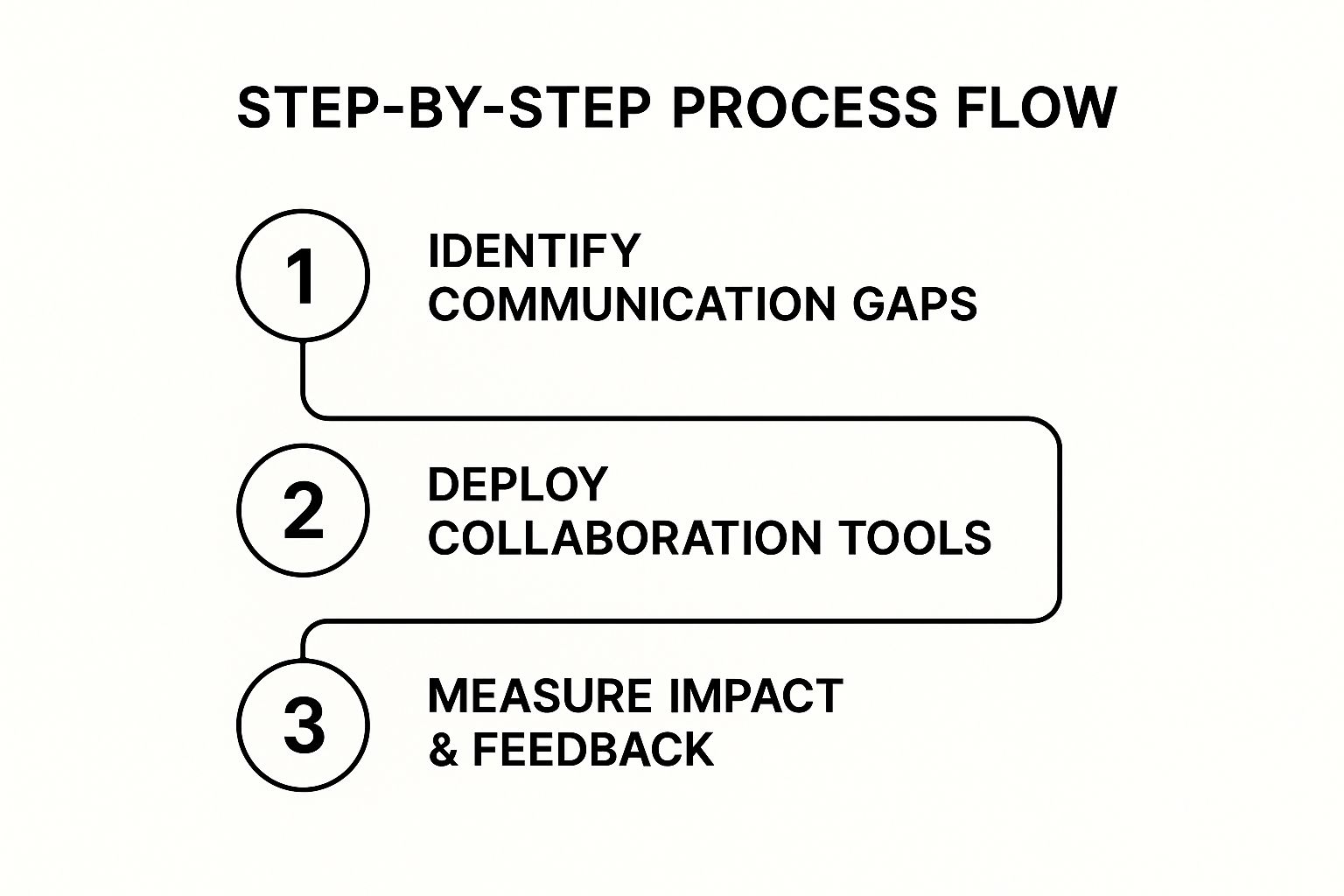Think about any high-performing company you admire. It probably seems to move with a certain kind of harmony, right? Marketing, engineering, sales, and support all appear to be on the same page, working together to create a fantastic customer experience.
That harmony doesn't happen by accident. It's the result of something we call cross-functional communication.
This is the structured, intentional exchange of information between people from completely different teams or departments. It’s the secret sauce for breaking down those invisible walls (we call them silos) that naturally form in a growing business, making sure everyone is pulling in the same direction. For any modern company that wants to be fast, innovative, and customer-focused, this isn't just a nice-to-have; it's absolutely essential.
The Hidden Engine of High-Performing Companies

Let's stick with the harmony idea for a second. Picture a symphony orchestra. Each section—strings, brass, woodwinds, percussion—is like a different department. Now, imagine if each section played from a different sheet of music or just ignored the others completely. The result would be a mess.
But when they all follow the same conductor and play from the same score, listening to one another, they create something powerful. That beautiful music is cross-functional communication in action. It’s the invisible engine that transforms a group of talented but separate teams into a single, cohesive organization.
Why Traditional Silos Are Failing
In the past, businesses were often built with strict departmental silos. Information flowed up and down within a team's hierarchy, but it rarely traveled sideways to other departments. This rigid structure just doesn't work anymore.
Today's market demands speed and adaptability, and siloed teams can't keep up. When the marketing team has no idea what engineering is building, or the sales team can't get a straight answer from support, the entire business slows down, and customers feel the friction.
This disconnect is a huge problem. It’s no surprise that a staggering 83% of companies now rely on cross-functional teams to improve how they work together. And the people on the ground feel it too—97% of employees say that a lack of alignment negatively impacts their projects.
The core problem with silos is that they create an "us vs. them" mentality. Effective communication replaces this with a unified "we" mindset, focusing everyone on shared customer and business goals.
This isn't just some passing trend; it's a fundamental shift in how successful companies operate. When you build an environment where information flows freely between departments, you can innovate faster and respond to what customers actually want, not what you think they want.
Mastering this is a true game-changer. If you want to dive deeper into the nuts and bolts, you can learn more about the fundamentals in our guide on cross-functional team communication. This article will walk you through the strategies and tools you need to start building that synergy in your own organization.
Why Effective Collaboration Is No Longer Optional

We can talk theory all day, but the real value of cross-functional communication shows up in tangible business results. When teams get this right, it’s not just a nice cultural win; it’s a powerful strategic advantage that you can see on the bottom line. It’s the difference between a product that launches smoothly and one that’s a mess of last-minute scrambles and missed deadlines.
Frankly, seamless collaboration has moved far beyond being a "nice-to-have." It's now a core driver of growth and efficiency.
Imagine a product launch where engineering and marketing are perfectly in sync from the get-go. Marketing actually gets the technical capabilities and limitations, so they can craft a message that’s both compelling and realistic. At the same time, engineering understands what the market truly needs, helping them prioritize features that customers will actually care about. This kind of synergy stops wasted effort in its tracks and ensures the product lands with maximum impact.
This isn't just a fantasy scenario. When information flows freely between departments, the entire product development lifecycle picks up speed. Problems get spotted and solved faster, decisions are made with the full picture in view, and the entire organization becomes quicker and more responsive to whatever the market throws at it.
Accelerating Product Development Cycles
One of the most immediate payoffs of solid cross-functional communication is speed. When teams work in their own little bubbles, projects get bogged down by a painful series of handoffs. Engineering builds something, tosses it over to QA, who then passes it to marketing. If a problem pops up, the whole process has to go in reverse, creating expensive delays.
Good communication breaks this bottleneck. Instead of a slow, linear relay race, it creates a living, breathing feedback loop.
- Real-Time Problem Solving: A developer can ping a support agent to understand the real-world context of a bug a customer just reported.
- Reduced Rework: Marketing can give early feedback on a feature's design, preventing a huge, costly overhaul after it's already been built.
- Efficient Resource Allocation: Project managers get a clear, live view of progress across every team involved, letting them shift resources to where they're needed most.
This collaborative vibe replaces friction with momentum. It turns those clunky sequential handoffs into a unified, parallel effort. The result? You get to market faster, which, in today's competitive world, can make all the difference.
Igniting Innovation Through Diverse Expertise
Real innovation rarely happens in a vacuum. The big breakthroughs usually spark at the intersection of different disciplines. When you bring together the analytical mind of an engineer, the market sense of a salesperson, and the customer empathy of a support agent, you create the perfect environment for new ideas to flourish. This is where mastering cross-functional communication really pays off.
A recent study found that a staggering 75% of cross-functional teams fail. A top reason is the lack of clear, shared goals and competing priorities between departments—making a case for just how critical unified alignment really is.
Think about what happens when a critical customer issue arises. In a siloed company, the support team might be pulling their hair out trying to get a technical fix, while the customer gets more and more frustrated. With great collaboration, the whole picture changes.
The support agent, sales rep, and an engineer can jump on the problem together. The sales rep gives context on how valuable the customer is, the support agent explains the user's specific pain point, and the engineer can dive right into a technical solution. This united front doesn't just solve the problem faster—it completely elevates the customer experience, turning a potential disaster into a moment that builds serious loyalty.
Of course. Here is the rewritten section, crafted to sound completely human-written and natural, following all your specified requirements.
Why Good Teams Go Sideways: Diagnosing the Roadblocks

Even when everyone has the best of intentions, getting different teams to work together can feel like herding cats. You’ve probably seen it before: projects slow to a crawl, frustration mounts, and nobody seems to be on the same page. These aren't random occurrences; they're symptoms of common, predictable roadblocks.
The first step to dismantling these barriers is learning to spot them in the wild.
Lost in Translation: The Problem with Departmental Dialects
One of the biggest culprits is something I call "departmental dialects." Your marketing team is buzzing about "MQLs" and "SQLs," but to your engineers, that's just alphabet soup. They're focused on "sprints," "epics," and "story points." It’s like they're speaking two completely different languages.
This isn't just a quirky communication tic—it's a genuine barrier. When teams talk at each other instead of with each other, crucial details get lost. Misunderstandings lead to wasted time, flawed work, and a whole lot of rework. It's a huge reason why a staggering 75% of cross-functional teams reportedly fail. They can't find common ground because they can't even agree on the vocabulary.
When Good Goals Go Bad: Conflicting Priorities
Another classic roadblock pops up when teams are chasing different metrics. Picture this: the sales team has a quota to hit this quarter, so they're all about closing deals fast. Meanwhile, the engineering team is bonused on shipping stable, bug-free code, which takes time and careful planning.
Suddenly, you have an unintentional conflict. Sales promises a shiny new feature to a hot prospect, but engineering hasn't even scoped it out. From the sales perspective, engineering is a bottleneck. From the engineering perspective, sales is making unrealistic promises. In reality, both teams are just doing their jobs.
The core issue isn't the people; it's the system. When departmental goals aren't aligned with overarching company objectives, you create an environment of internal competition instead of collaboration.
This friction quickly devolves into an "us vs. them" mentality. Departments build walls around their resources and priorities, protecting their own turf instead of working toward a shared victory. This erodes the trust needed for open, honest communication, poisoning the well for any real collaboration.
Symptom Spotting: Where Does It Hurt?
These communication breakdowns don't just happen in a vacuum; they show up as tangible problems across the business. I've seen these patterns time and time again.
Here's a quick look at some common symptoms and what might really be going on under the surface.
Common Communication Breakdowns
| Symptom | Potential Cause | Impact on Business |
|---|---|---|
| Missed Deadlines | Teams have conflicting schedules and priorities. | Delayed product launches, lost revenue opportunities. |
| Endless "Status Update" Meetings | No single source of truth for project progress. | Wasted employee time, meeting fatigue, low productivity. |
| Finger-Pointing and Blame | Lack of shared ownership and "us vs. them" culture. | Low morale, high employee turnover, toxic work environment. |
| Inconsistent Customer Experience | Sales, support, and product aren't aligned. | Customer frustration, increased churn, damaged brand reputation. |
| Rework and Duplicated Efforts | Information is siloed, leading to redundant tasks. | Wasted resources, inflated project costs, inefficiency. |
Recognizing these symptoms is crucial. They're the warning signs that your cross-functional communication strategy needs a serious tune-up before small issues spiral into major business problems.
The Tool-Sprawl Trap: Disconnected Systems
Finally, let's talk about the digital mess that is tool-sprawl. Your support team lives and breathes in HubSpot. Your engineers are glued to Jira. And maybe your product managers are using a third tool entirely. This is the modern-day equivalent of putting each team on a separate, isolated island.
When information gets trapped in these digital silos, you’re operating with an incomplete picture. This creates a whole host of problems that kill efficiency and morale:
- Death by a Thousand Meetings: Teams are forced into constant, low-value sync-ups just to figure out what everyone else is doing. It’s a huge time sink.
- The Manual Copy-Paste Grind: Someone has to waste their day manually transferring data from one system to another. It's tedious, mind-numbing, and a recipe for human error.
- Decision Paralysis: Without all the facts in one place, leaders can't make fast, informed decisions. Everything slows down.
These aren't just minor tech headaches. They are fundamental obstacles that choke the flow of information your teams need to succeed. Moving past them requires a smart approach to both your processes and your tech stack, which is exactly what we'll get into next.
Proven Strategies for Breaking Down Silos
Pinpointing the roadblocks is one thing, but actually knocking them down is where the real work begins. To get your cross functional communication humming, you need more than just good intentions—you need a practical playbook. These strategies are tried and true, designed to turn isolated teams into a single, high-performing unit.
The first step is building a foundation of shared understanding. This isn't about making your marketers become engineering experts or vice versa. It's about creating just enough common ground so that when a marketer, an engineer, and a support agent get in a room, they can have a productive conversation without getting tangled up in jargon.
This process is about spotting the communication gaps, finding the right tools to close them, and then checking back to see if your efforts are actually making a difference.

As you can see, breaking down silos isn't a one-and-done fix. It's a cycle of identifying problems, trying out solutions, and refining your approach over time.
Create a Shared Company Vocabulary
One of the quickest wins you can score is simply getting everyone to speak the same language. This means creating a central, easy-to-access glossary that defines the key terms, acronyms, and metrics flying around different departments.
When terms like "MQL" (Marketing Qualified Lead) and "P1 Bug" (Priority 1 Bug) are clearly defined for the whole company, misunderstandings plummet. This simple act of creating a common dictionary ensures that when teams talk, they're actually communicating. For a deeper dive, you can read more about breaking down silos in the workplace and find some practical tips for your own teams.
Develop Cross-Functional Project Charters
Before a single line of code is written or a single campaign is launched, get leaders from every involved team in a room to draft a project charter. Think of this document as a pact—a formal agreement that gets everyone aligned on what truly matters.
A solid project charter should nail down:
- Unified Goals: What's the one overarching objective we're all shooting for? This needs to be a business goal, not just a departmental one.
- Key Performance Indicators (KPIs): How will we know if we've won? These metrics have to be shared and tracked by everyone involved.
- Roles and Responsibilities: Who is doing what? A RACI (Responsible, Accountable, Consulted, Informed) chart is perfect for mapping this out.
- Communication Plan: How and how often will we connect? Define your channels (like Slack, Jira, or weekly meetings) and the schedule.
This charter becomes the project's "North Star," preventing the kind of priority clashes that can completely derail collaborative work.
Implement Structured Communication Rituals
Spontaneous collaboration is fantastic when it happens, but you can't build a strategy on it. Structured rituals are what make great communication reliable and repeatable. These are scheduled, recurring meetings with a clear purpose that forces different teams to connect.
The most effective communication rituals are brief, focused, and actionable. They aren't for endless status updates; they're for solving problems and making decisions together.
Consider putting a few of these key rituals on the calendar:
- Joint Stand-Ups: A quick, 15-minute daily or bi-weekly check-in where reps from each team share progress, blockers, and what's next.
- Cross-Functional Demos: At the end of a sprint or milestone, teams show their work to the entire project group. This builds a sense of shared ownership and is a great way to get immediate feedback.
- Regular Retrospectives: A dedicated meeting to talk about what went well, what didn't, and how to work together better in the next cycle.
These routines build the muscle memory for communication. To put these ideas into action and really bridge departmental divides, check out these strategies to boost team communication and collaboration.
Appoint a Project Lead as a Translator
For really complex projects—especially those mixing technical and non-technical teams—having a skilled project lead is non-negotiable. This person isn't just a manager; they are a translator.
Their job is to be the bridge, making sure business needs are crystal clear to engineers and that technical limitations are clearly explained back to business stakeholders. This role is absolutely vital for keeping everyone on the same page.
Choosing the Right Tools for Seamless Collaboration
Strategies and rituals are a great start for improving cross-functional communication, but they can only take you so far. To truly break down the silos that plague the modern workplace, you need the right technology. Think of your tools as the central nervous system for your projects, making sure information flows freely and everyone can rely on a single source of truth.
Picture your different departments—sales, support, engineering—as separate islands. Without the right infrastructure, vital information gets stranded. A critical conversation on one island is completely unheard on another. Your tech stack is the bridge that connects these islands, allowing for a constant, effortless flow of people, ideas, and data.
The real goal isn't just to collect a bunch of separate apps, but to build a cohesive, interconnected system. This is how you stop confusion in its tracks and prevent teams from accidentally working against each other.
Building Your Collaborative Tech Stack
A solid tech stack for collaboration usually leans on three core types of tools. Each one plays a distinct role, but when they work together, they create a powerful ecosystem that supports genuine teamwork from every angle.
-
Instant Messaging Tools: Platforms like Slack or Microsoft Teams are your go-to for the fast-paced, real-time stuff. They're perfect for quick questions, informal check-ins, and urgent problem-solving that keeps projects moving without burying everyone in email.
-
Project Management Platforms: Tools such as Jira or Trello are the command centers for your projects. They provide much-needed structure by tracking tasks, deadlines, and who's responsible for what, giving the entire team a clear view of progress.
-
Document Collaboration Hubs: Systems like Google Workspace or Microsoft 365 let teams create, edit, and share documents, spreadsheets, and presentations together in real time. This single-handedly eliminates the nightmare of version control and ensures everyone is working from the most current file.
When you're piecing this together, it's also smart to look at how specialized platforms, like social media collaboration tools for teams, can plug into your stack to support specific workflows. The trick is to pick tools that not only excel on their own but also play nicely with others.
The Power of a Single Source of Truth
Let’s be honest: the biggest roadblock to effective cross-functional communication is a messy, fragmented information landscape. When customer data lives exclusively in HubSpot and development tasks are locked away in Jira, you've created a digital divide. This gap forces people into manual work and, inevitably, leads to costly misunderstandings.
This is exactly why integrations are no longer a "nice-to-have"—they're a must. A good integration acts as the critical link between your islands, creating one unified workflow.
Take a tool like our own HubSpot for Jira app. It doesn't just pass messages between two systems; it embeds vital HubSpot customer data directly into Jira issues. Suddenly, your engineering team gets all the context they need without ever having to leave their favorite workspace.
This connection completely changes how teams operate. A customer support ticket reporting a bug in HubSpot can automatically spin up a detailed Jira issue for developers. As engineers update the ticket's status in Jira, that information flows right back to HubSpot. This empowers the support team to give customers proactive, accurate updates instead of just saying, "we're looking into it."
This two-way sync kills the "us vs. them" mentality and dissolves information silos. It builds that essential bridge, making sure customer-facing and technical teams aren't just connected, but are truly collaborating. It's this growing reliance on integrated tools that explains why the global collaboration market is set to explode, projected to grow from $39.4 billion in 2023 to over $116 billion by 2033. You can explore more data on workplace collaboration trends on ProofHub.
How to Create a Unified Workflow With HubSpot and Jira
Strategies are great, but the real proof of effective cross-functional communication is seeing it in action. This is where the right technology steps in, acting as a powerful bridge between teams that have traditionally operated worlds apart. Let's walk through a common, high-stakes scenario to see how this actually works.
Imagine a support agent, deep in their HubSpot workflow. A ticket pops up from a high-value client who's hit a critical bug in your software. The customer is frustrated, and the agent needs to get answers from the engineering team—and fast.
In a disconnected company, this is where things grind to a halt. The agent might fire off an email, drop a note in another system, or try their luck catching a developer on Slack. Information gets lost, context vanishes, and the customer is left waiting. The classic "departmental dialect" problem rears its ugly head.
Bridging the Gap With Integration
This is precisely the kind of communication breakdown that a direct integration between HubSpot and Jira is built to fix. Instead of a messy, manual handoff, the entire process becomes a single, seamless flow.
With the right connection in place, the support agent can, with one click inside the HubSpot ticket, create a new issue directly in the engineering team’s Jira project. This isn't just about creating a link; it's a rich, complete transfer of knowledge.
The real game-changer here is context. The Jira issue is automatically filled with all the crucial customer data from HubSpot—company details, contact info, deal size, and the full ticket history. Suddenly, an engineer isn't just staring at a bug report; they're seeing the complete story of the customer it impacts.
This simple action completely dissolves the information silo. The engineer has everything they need to grasp the problem's priority and impact, all without ever leaving Jira.
This visual link between platforms is the key. It creates a single source of truth for both your customer-facing and technical teams, ensuring everyone is on the same page.
Creating a Two-Way Conversation
The real magic, though, happens when communication flows in both directions. This is what transforms cross-functional communication from a one-off message into a living, breathing dialogue.
As the engineering team works on the bug and updates the issue in Jira, those changes are automatically synced right back to the HubSpot ticket.
- When an engineer moves the issue from "In Progress" to "In Review," that new status is instantly visible in HubSpot.
- If a developer adds a comment in Jira asking for more details, it appears on the HubSpot timeline.
- Once the bug is squashed and the Jira issue is marked "Done," the HubSpot ticket is updated to match.
This two-way sync empowers the support agent to give proactive, intelligent updates to the customer. They no longer have to chase down engineers for a status report. The information is right there, inside the tool they live in every day. To explore this powerful connection further, you can learn more about the specifics of the HubSpot-Jira integration for support teams.
This unified workflow kills the manual copy-pasting, the endless status meetings, and the frustrating game of telephone. It replaces friction with flow, building a truly collaborative environment where sales, support, and engineering operate as one cohesive team, all focused on serving the customer.
A Few Common Questions
Even when you've got a solid plan and the right tools, getting true cross-functional communication off the ground always brings up a few practical questions. Let's tackle some of the most common things we hear from leaders and teams trying to finally break down those frustrating silos.
Getting a handle on these concerns is how you turn a good idea into something your teams actually do every day.
How Can We Measure the ROI of Improving Cross-Functional Communication?
This is a big one. Measuring the return on investment (ROI) here isn't just about one number; it’s about connecting better teamwork to real business results. You need to look at both hard data and the softer, cultural shifts.
Start with the easy stuff—the quantitative metrics. You're looking for tangible improvements like:
- Projects getting done faster.
- Fewer bugs or costly errors in product launches.
- Customer support tickets getting resolved in less time.
Then, you have to look at the qualitative side. Use regular, simple employee surveys to get a pulse on engagement and see if people feel it’s actually easier to work with other departments. When you can draw a straight line from faster project cycles and happier, more engaged employees to more revenue, better customer retention, or lower costs, you've got a powerful story to tell about ROI.
What Is the First Step a Small Business Should Take?
If you're a small business, the single most powerful first step you can take is to create a single source of truth. Don't overthink it; this doesn't need to be some massive, expensive system.
Honestly, it can be as simple as a shared project board in a tool you already use, or even a central document that tracks goals, who's responsible for what, and the progress on your most important projects. The whole point is to get information out of scattered email threads and private messages and into one place where everyone is on the same page.
Once you have that central hub, the next logical move is to schedule a quick, regular cross-functional check-in. It's a simple ritual, but it does wonders for keeping everyone aligned and the communication flowing.
How Do You Handle Team Members Who Are Resistant to Collaboration?
Resistance to change is human. It usually stems from a fear of losing control or simply not seeing what's in it for them. The trick is to approach this with empathy and evidence, not by forcing it on them.
A fantastic way to start is with a small pilot project. Grab a few people who are genuinely excited about working together and give them a clear goal. Document their process and, most importantly, shout their success from the rooftops. Show everyone else the efficiency gains and the great results.
It's also absolutely critical that leadership keeps explaining the "why" behind this shift. This isn't about taking away individual autonomy. It's about a collective game plan to hit bigger, more exciting goals together. Success stories are always more persuasive than mandates.
Ready to create a unified workflow and eliminate the friction between your sales, support, and engineering teams? See how resolution Reichert Network Solutions GmbH can connect HubSpot and Jira to build a single source of truth for your entire organization. Explore HubSpot for Jira today.
